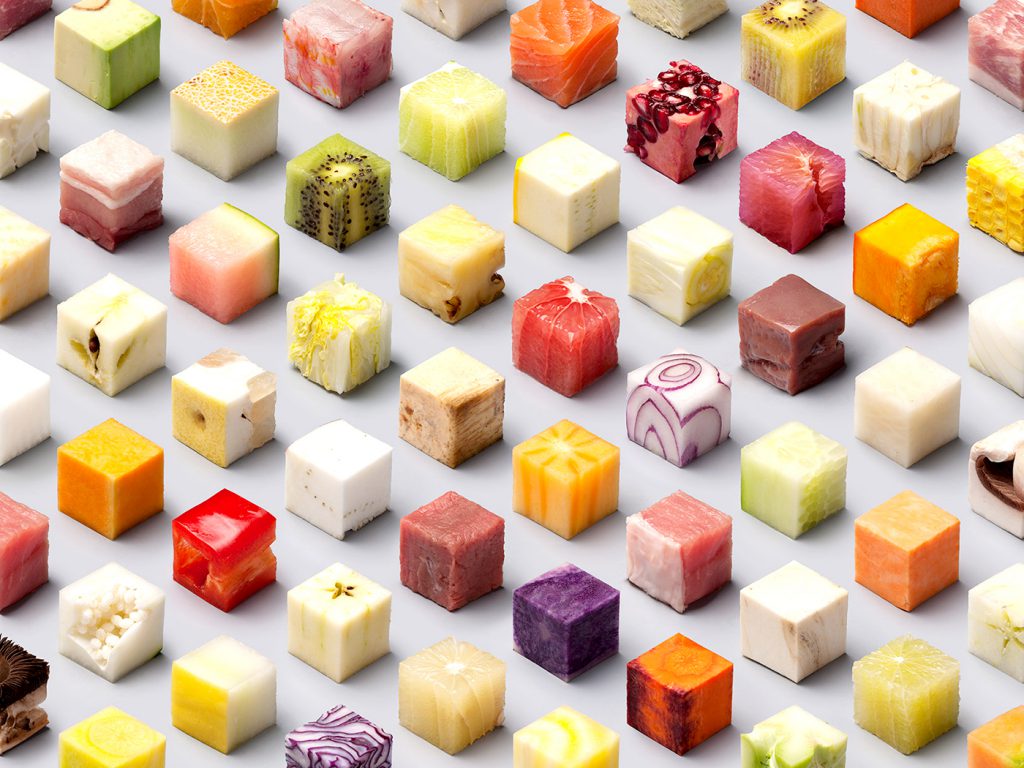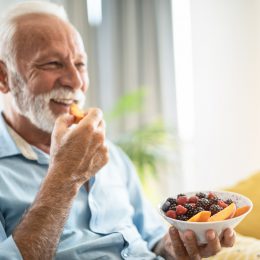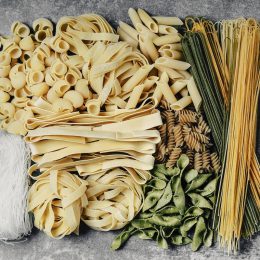The New Food Pyramid for Older Adults
The nutrition guidelines you grew up with are outdated. Here’s how to feed your body what it really needs.

It’s never too late to start eating healthier. But if it’s been a while since you’ve checked your habits, you may need a refresher on what a “well-balanced diet” actually means these days.
The general recommendations from yesteryear–including the USDA’s Basic Four food groups, the Food Wheel, and the Food Guide Pyramid–are outdated. Now the USDA uses a MyPlate icon that serves as a reminder for healthy eating, showing about how much Americans should consume from each of five categories: fruits, vegetables, grains, protein, and dairy.
Unlike its predecessors, MyPlate is not intended to provide specific guidelines but rather offers ideas and tips to help you create a healthier eating style that meets your individual needs. That may not sound very helpful at first, but it’s based on the fact that a healthy diet isn’t exactly the same for everyone. It’s shaped by many factors, including preferences, access to food, culture, traditions, and your stage of life.
That last one is especially important: Dietary needs change with age—and that means your diet might need an update too. That’s why researchers at the Jean Mayer USDA Human Nutrition Research Center on Aging (HNCRA) at Tufts University created a modified version of MyPlate called MyPlate for Older Adults, which offers the following basic guidelines:
- Half of your plate should be fruits and vegetables of various colors.
- A quarter of your plate should be grains—with an emphasis on whole grains (for example, whole wheat bread, brown rice, and oatmeal).
- The remainder should be protein (nuts, beans, fish, poultry, and lean meat) and a little bit of low-fat or fat-free dairy (milk, yogurt, and cheese).
Beyond those basics, here are five guidelines tailored for older adults.
1. Season with Spices, Not Salt
“The dietary guidelines suggest that adults get less than 2,300 milligrams of sodium each day,” says Lauri Wright, Ph.D., R.D.N., an assistant professor of nutrition and dietetics at the University of North Florida. But most Americans get more than that. Women ages 51 to 70 typically get about 2,900 milligrams per day—but men the same age get about 4,000 mg per day.
That’s a problem. “Excess sodium intake can raise our blood pressure, leading to an increased risk for heart disease, stroke, and kidney disease,” Wright says.
If you’ve noticed an increased urge to add salt to your food over the years, it might not be the chef’s fault. Our sense of taste weakens with age, so dishes you once loved may seem to lose their flavor. This not only makes meals less enjoyable, but for some, it could contribute to a serious lack of appetite—or even malnutrition.
The low-sodium solution: Flavor your meals with herbs and spices, says Jen Bruning, R.D.N., a spokesperson for the Academy of Nutrition and Dietetics. You can often make delicious, salt-free blends with ingredients you already own, like basil and oregano.
Want more ideas? Check out our spice cheat sheet to make a handful of versatile blends that are anything but bland.
2. Load Up on Calcium and Vitamin D
Calcium and vitamin D are an important pair of nutrients. Calcium helps control blood pressure and is crucial for bone health, and vitamin D allows your body to absorb the calcium from foods you eat, among other things.
The problem: There’s a good chance you’re not getting enough of either. With age, your need for both increases.
For calcium, the National Institutes of Health recommends:
- Men, 51 to 70 years: 1,000 milligrams per day
- Men, 71 years and older: 1,200 milligrams per day
- Women, 51 years and older: 1,200 milligrams per day
For vitamin D:
- Adults, 50 to 70 years: 600 IU per day
- Adults, 70 years and older: 800 IU per day
Low-fat and fat-free dairy products like milk, yogurt, and cheese are great sources of calcium, but you can still get your daily dose if those options upset your stomach. “Alternative calcium-rich foods include soy, kale, sardines, broccoli, and calcium-fortified orange juice,” Wright says.
As for vitamin D, good options include egg yolks and fatty fish like salmon, tuna, and mackerel, as well as fortified foods such as milk, breakfast cereals, and some yogurts, says Kristin Koegel, R.D., a nutritionist with the USDA Center for Nutrition Policy and Promotion.
Need inspiration? Try a hearty kale salad or an open-faced tuna and veggie sandwich. Get the recipes here.
3. Fill Your Plate with Fiber
“Constipation is common in seniors because of factors like inactivity and taking certain medications,” Wright says. “And fiber is critical to keep the digestive tract moving.”
But that’s not the only benefit of a high-fiber diet. It may also help reduce cholesterol and regulate blood sugar levels, thus lowering your risk of heart disease and type 2 diabetes. Plus, fiber keeps you feeling full for longer periods of time, which may help you reduce your calorie consumption and lose excess weight.
“The best sources of dietary fiber are whole grain products, legumes, fruits, and vegetables,” Koegel says.
The good news is that if you use the MyPlate for Older Adults guidelines—half your plate with fruits and vegetables, a quarter of your plate with good grains—you’ll be able to get your fiber pretty easily. Fiber-rich recipes like arugula lentil salad or three-bean veggie chili can help too. Get the recipes here.
If you haven’t been eating a lot of fiber-rich foods, add them to your diet gradually and drink plenty of water to minimize digestive distress. And if you have a difficult time getting enough fiber, talk to your doctor, who may recommend a supplement like Metamucil or Citrucel.
Subscribe to our newsletter
It's quick and easy. You could be one of the 13 million people who are eligible.
Already a member? Click to discover our 15,000+ participating locations.
Follow Us
4. Be Vigilant About Vitamin B12
While the recommended daily allowance for vitamin B12 doesn’t increase with age for adults, your body’s ability to absorb the nutrient from foods decreases, Koegel says, so it’s important to increase your intake.
Low levels of B12 can cause fatigue, problems concentrating, dizziness, numbness, and tingling in fingers and toes. Severe, long-term deficiency may lead to problems walking, memory loss, or depression.
“Your doctor can perform a lab test to see if your B12 levels are adequate and make recommendations about the best course of action if levels are low,” Bruning says.
Your diet is often the best way to get B12. “Foods fortified with vitamin B12, such as fortified breakfast cereals, can help,” Koegel says. Other options include trout, salmon, tuna, plain Greek yogurt, milk, and eggs.
How about pecan-crusted seared salmon? Get the recipe here.
5. Drink More Fluids, Even When You’re Not Thirsty
“Older adults don’t need more fluid than younger adults, but the relationship between state of hydration and thirst diminishes with age,” says Alice H. Lichtenstein, D.Sc., director of the HNCRA Cardiovascular Nutrition Laboratory.
In other words, you may not experience the sensation of thirst as strongly as you used to. “For this reason, older adults need to be more aware of the need to consume fluids and not just rely on their body signaling when to drink,” Lichtenstein says. (Our guide to five lesser-known signs of dehydration can help.)
Keep a refillable water bottle with you when possible, and drink a full glass with every meal. “Water is the best for hydration, but jazzing it up with mint, cucumber, or fruit can make it more appealing,” Bruning says.
In addition to H2O, fluid-filled foods like fruit and soup—along with beverages like tea and fruit juice—help hydrate you too. Just choose 100 percent fruit juice and steer clear of bottled teas, which are often packed with added sugars.
Check Your SilverSneakers Eligibility Instantly
SilverSneakers gives you free, unlimited access to more than 15,000 gyms and fitness centers across the nation, plus classes and tools designed to keep older adults strong and independent. Check your eligibility instantly here.




